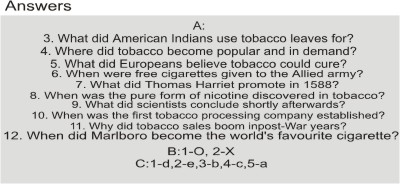|
Education


The situation
In Europe, it is widely believed that within a few years a total ban on tobacco smoking in public places will be enforced. According to a British Government White Paper, by the end of 2007, "all enclosed public places and workplaces, except for licensed premises will be smoke-free . . . ." Actually, in Europe, England has fallen behind in the race to put anti-smoking legislation into place. The Irish Republic has taken first honours. Since 29th March, 2004 the Irish Government has implemented a ban on smoking in the workplace in Ireland. This means that, with effect from that date smoking is forbidden in enclosed places of work in Ireland. This includes office blocks, various buildings, public houses/bars, restaurants and company vehicles (cars and vans). The ban was introduced as part of the Public Health (Tobacco) Act, 2002 (Section 47). Smoking has been identified as a major cause of heart disease and a significant contributor to lung cancer in Ireland. Italy and Norway have also introduced anti-smoking legislation.
But what exactly is tobacco, you might be asking, and how did it manage to take such a strong hold on our society? Some of the answers are given below:
The background. Some facts about tobacco and the tobacco business
1. Tobacco is a plant that originally comes from North and South America.
2. American Indians used tobacco leaves for religious and medicinal purposes.
3. Columbus was given dried tobacco leaves as a gift on his arrival in America in 1492.
4. Very quickly, tobacco became popular and in great demand all over Europe.
5. Europeans believed that tobacco could heal anything from bad breath to cancer.
6. In 1588, Thomas Harriet promoted smoking tobacco as a way of taking the drug.
7. The first tobacco processing company was established in New York City in 1760.
8. It wasn't until 1826 that the pure form of nicotine was discovered in tobacco.
9. Shortly afterwards, scientists concluded that it was a dangerous and addictive poison.
10. During World War II, free cigarettes were given to the Allied soldiers.
11. Tobacco sales boomed in post-War years partly because of tobacco addiction.
12. By the end of the 20th century, Marlboro was the world's No 1 brand of choice.
A Answers and Questions
Short answers on this topic are given below. Form (short) questions to match them.
Two examples are given.
Questions Answers
1. Where does tobacco originally come from? North and South America.
2. What was given to Columbus on his arrival? dried tobacco leaves.
3. religious and medicinal purposes
4. all over Europe.
5. anything from bad breath to cancer
6. during World War II
7. smoking tobacco
8. not until 1826
9. it was a dangerous, addictive poison
10. in New York City in 1760
11. partly because of tobacco addiction
12. by the end of the 20th century
Short answers on this topic are given below. Form (short) questions to match them.
Two examples are given.
Questions Answers
1. Where does tobacco originally come from? North and South America.
2. What was given to Columbus on his arrival? dried tobacco leaves.
3. religious and medicinal purposes
4. all over Europe.
5. anything from bad breath to cancer
6. during World War II
7. smoking tobacco
8. not until 1826
9. it was a dangerous, addictive poison
10. in New York City in 1760
11. partly because of tobacco addiction
12. by the end of the 20th century. In the Republic of Ireland just under 25% of the population smoke and the purpose of this smoking ban is to offer protection to employees and the majority members of the non-smoking public who are exposed to the harmful and toxic effects of tobacco smoke in the workplace and in public places - the so-called "passive smokers".
The conflict
In considering the history of this thorny issue it is clear that the underlying conflict is between business interests and public health concerns. Over the past decades, millions of dollars have been spent by well-known cigarette companies in litigation, mostly in an attempt to delay public admission that it is possible to establish a causal link between smoking cigarettes and lung cancer.
The language
Legal language is always difficult. Look at these two definitions of a cigarette given below.
B The definition of a cigarette. Decide which is the view of an anti-smoking campaigner (x) and which is the view of a tobacco company representative (o)

C Match one word from list (a) with a meaning from list (b)

DUBLIN, Ireland most bar owners and pub-goers declared Ireland's smoking ban a success after the country became the first in the world to outlaw smoking in workplaces.
Here are some opinions on the subject:
Andy, non smoker: "Great, very good. It's cleaner".
Marian, non-smoker: "I'm in favour of the smoking ban. Before the ban you had to be a passive smoker and get smelly clothes".
Myles, smoker: "It's a bad decision. The Government shouldn't tell me what to do".
Norman, smoker: "It's a good thing, especially for people who try to quit smoking".
Mona, non-smoker: "I am surprised Ireland is the first country which bans smoking. It's a good idea, I love it".
Now give your opinion on the subject. Write down three reasons to support your opinion about whether a ban on smoking in public would be a good idea or not.
1._____________________________________________________________________
2._____________________________________________________________________
3._____________________________________________________________________

Copyright
(R) thedailystar.net 2005 |
